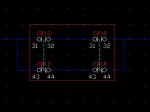I am working on a project that evolves error checking using relays. Assume two relays both with a set of NO and NC contacts are wired as shown below. Under normal operation assume both coils of the two relays will be actuated simultaneously. Applying a 24v signal on the left side then monitoring the resulting signal on the right side there will be a loss of the signal as the relays change state due to bouncing and subtle time differences in the relays ability to change state.
What would be the easiest way to eliminate any loss of signal (provided the loss is not over 250ms) as these relays change state? Using discrete components excluding any IC chips.

What would be the easiest way to eliminate any loss of signal (provided the loss is not over 250ms) as these relays change state? Using discrete components excluding any IC chips.


